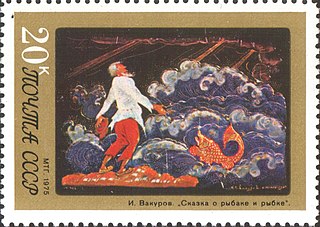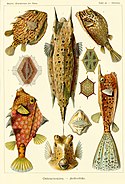The serpent, or snake, is one of the oldest and most widespread mythological symbols. The word is derived from Latin serpens, a crawling animal or snake. Snakes have been associated with some of the oldest rituals known to humankind and represent dual expression of good and evil.

A fisherman or fisher is someone who captures fish and other animals from a body of water, or gathers shellfish.

Teleostei, members of which are known as teleosts, is, by far, the largest infraclass in the class Actinopterygii, the ray-finned fishes, and contains 96% of all extant species of fish. Teleosts are arranged into about 40 orders and 448 families. Over 26,000 species have been described. Teleosts range from giant oarfish measuring 7.6 m (25 ft) or more, and ocean sunfish weighing over 2 t, to the minute male anglerfish Photocorynus spiniceps, just 6.2 mm (0.24 in) long. Including not only torpedo-shaped fish built for speed, teleosts can be flattened vertically or horizontally, be elongated cylinders or take specialised shapes as in anglerfish and seahorses.

The ichthys or ichthus, from the Greek ikhthū́s is a symbol consisting of two intersecting arcs, the ends of the right side extending beyond the meeting point so as to resemble the profile of a fish. It has been speculated that the symbol was adopted by early Christians as a secret symbol; a shibboleth to determine if another was indeed Christian. It is now known colloquially as the "Jesus fish".

Deer have significant roles in the mythology of various peoples located all over the world, such as object of worship, the incarnation of deities, the object of heroic quests and deeds, or as magical disguise or enchantment/curse for princesses and princes in many folk and fairy tales.

The Tale of the Fisherman and the Fish is a fairy tale in verse by Alexander Pushkin, published 1835.
The Aarne–Thompson–Uther Index is a catalogue of folktale types used in folklore studies. The ATU index is the product of a series of revisions and expansions by an international group of scholars: Originally published in German by Finnish folklorist Antti Aarne (1910), the index was translated into English, revised, and expanded by American folklorist Stith Thompson, and later further revised and expanded by German folklorist Hans-Jörg Uther (2004). The ATU index is an essential tool for folklorists, used along with Thompson (1932)Motif-Index of Folk-Literature.

The ichthys symbol is a sign typically used to proclaim an affiliation with or affinity for Christianity. The fish was originally adopted by early Christians as a secret symbol, but the many variations known today first appeared in the 1980s. Some of these are made by Christians in order to promote a specific doctrine or theological perspective, such as evolutionary creation. Other variations are intended for the purpose of satire by non-Christian groups.

Frogs play a variety of roles in culture, appearing in folklore and fairy tales such as the Brothers Grimm story of The Frog Prince. In ancient Egypt and Mesopotamia, frogs symbolized fertility, while in classical antiquity, the Greeks and Romans associated frogs with fertility, harmony, and licentiousness.

A fish is an aquatic, anamniotic, gill-bearing vertebrate animal with swimming fins and a hard skull, but lacking limbs with digits. Fish can be grouped into the more basal jawless fish and the more common jawed fish, the latter including all living cartilaginous and bony fish, as well as the extinct placoderms and acanthodians. Most fish are cold-blooded, their body temperature varying with the surrounding water, though some large active swimmers like white shark and tuna can hold a higher core temperature. Many fish can communicate acoustically with each other, such as during courtship displays.
The Golden-Headed Fish is an Armenian fairy tale. It was first collected by ethnologue and clergyman Karekin Servantsians in Hamov-Hotov (1884) with the title ԱԼԹՈՒՆ ԲԱՇ ԲԱԼԸՂ.
"The King of Lochlin's Three Daughters" is a Scottish fairy tale collected by John Francis Campbell in his Popular Tales of the West Highlands, listing his informant as Neill Gillies, a fisherman near Inverary.

The Knights of the Fish is a Spanish fairy tale collected by Fernán Caballero in Cuentos. Oraciones y Adivinas. Andrew Lang included it in The Brown Fairy Book. A translation was published in Golden Rod Fairy Book. Another version of the tale appears in A Book of Enchantments and Curses by Ruth Manning-Sanders.

Go I Know Not Whither and Fetch I Know Not What is a Russian fairy tale collected by Alexander Afanasyev in Narodnye russkie skazki.

The lion has been an important symbol to humans for tens of thousands of years. The earliest graphic representations feature lions as organized hunters with great strength, strategies, and skills. In later depictions of human cultural ceremonies, lions were often used symbolically and may have played significant roles in magic, as deities or close association with deities, and served as intermediaries and clan identities.

The Norka is a Russian and Ukrainian fairy tale published by Alexander Afanasyev in his collection of Russian Fairy Tales, numbered 132.

Emelya the Simpleton or At the Pike's Behest is a Russian fairy tale collected by Alexander Afanasyev in Narodnye russkie skazki.
Ethnoichthyology is a multidisciplinary field of study that examines human knowledge of fish, the uses of fish, and importance of fish in different human societies. It draws on knowledge from many different areas including anthropology, ichthyology, economics, oceanography, and marine botany.

The harvesting and consuming of seafoods are ancient practices that may date back to at least the Upper Paleolithic period which dates to between 50,000 and 10,000 years ago. Isotopic analysis of the skeletal remains of Tianyuan man, a 40,000-year-old modern human from eastern Asia, has shown that he regularly consumed freshwater fish. Archaeology features such as shell middens, discarded fish bones and cave paintings show that sea foods were important for survival and consumed in significant quantities. During this period, most people lived a hunter-gatherer lifestyle and were, of necessity, constantly on the move. However, where there are early examples of permanent settlements such as those at Lepenski Vir, they are almost always associated with fishing as a major source of food.

Fish are an important motif in Chinese mythology. There are various myths involving fish. Chinese mythology refers to those myths found in the historical geographic area of China. The geographic area of "China" is of course a concept which has evolved of changed through history. Fish in Chinese mythology include myths in Chinese and other languages, as transmitted by Han Chinese as well as other officially recognized 56 minority ethnic groups in China. The Chinese word for "fish", yu, is a homophone for "abundance", "plenty", and "affluence" ; therefore, fishes are a symbol of wealth. The Chinese dragon is the head of the fish clan. The act of fishing is also an important motif in Chinese mythology and culture.





































